
A Cave of Candles / by Dorothy V. Corson

Chapter 16
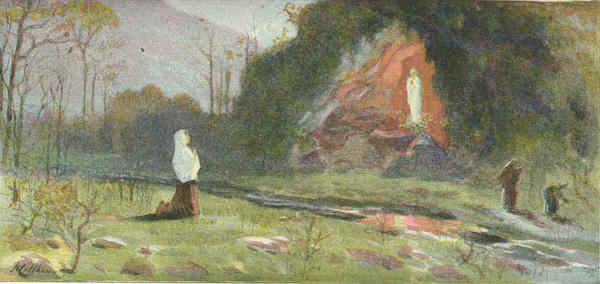
Bernadette and Lourdes
My notion to read the history of St. Mary's had paid off in more than one way. When I stopped at the convent library to pick up additional books Sister Paulette had set aside for me, I noticed several books with the word Lourdes in their titles on the shelf behind her check-out desk. As she was checking my books out, I took a closer look at them. All of them appeared to be on St. Bernadette and Lourdes. One in particular was filled with pictures.
Although I knew of the Bernadette story from the 1943 movie, The Song of Bernadette, I'd never read any books about her. Peter Lysy's suggestion of more than a year before, that my reading the background of Bernadette would be worthwhile, came back to me. I made a mental note to take them out when I returned the ones I had borrowed.
Notre Dame's Ave Maria was among these books along with a pictorial book on the Lourdes Grotto in France by Leonard Von Matt and one entitled: The Glories of the Catholic Church in Art, Architecture and History.(187)
An article in the Ave Maria, reprinted from the London Lamp, on January 1, 1870, detailed the phenomenon of the Grotto of Massabielle in Lourdes, France:
The simple facts are these. On the 11th of February, 1858, a humble, ignorant peasant child, named Bernadette Soubirous, being sent by her parents, together with her two companions, to fetch some dead wood by a mountain stream, close to a grotto, known in the country by the name of "The Grotto of Massabielle," suddenly saw in an inaccessible place an apparition, clothed in white and radiant beyond description. This apparition returned at stated times, as it had promised, on eighteen different occasions; it spoke to the child, commanding her to tell the clergy to have a chapel built on the spot; and at its word a miraculous spring burst forth under the hands of the child, in the presence of hundreds of spectators, from the dry hard rock of the grotto, which miraculous source gave sight to the blind, feet to the lame, and healing to the sick of all ages, conditions, and maladies. These miraculous appearances were doubted by the clergy, roused the opposition of the Government, and convulsed the whole country for eight months, when a word from the Emperor left the people in peace to follow their own convictions. From that time until now the number of pilgrims and of miraculous cures have been steadily increasing, and a very beautiful church has been built on the spot indicated by the vision.
Leonard Von Matt's book, which is mostly pictures, covered beautifully the countryside and Grotto area with a number of pictures of Bernadette at the time she first saw the apparitions. In addition, I made another lucky find, a close-up picture of the Our Lady of Lourdes statue, the original one, placed in the Grotto at Lourdes, France. I compared it to the photographs I'd taken of the statues in the Lourdes Hall alcove and was able to verify that, indeed, both Mother Angela and Father Sorin must have brought back from Paris an exact copy of the Our Lady statue at Lourdes done by the same sculptor. Not having seen Lourdes myself, to find Von Matt's lovely illustrated book about St. Bernadette, Lourdes, and the surrounding countryside, was was like being there myself.
The second book was written by Maurice Francis Egan who was brought to Notre Dame from New York by Fr. Walsh to chair the Literature Department. He lived adjacent to the campus on Notre Dame Avenue in a home built for him by the university. Egan loved lilacs. He wrote to all his friends asking them to send him different varieties of the bush to make a hedge around his home. He then christianed it, "The Lilacs," a name it still retains today.
It is worthy of note that Maurice Francis Egan's impressive book, The Glories of the Catholic Church in Art, Architecture and History was published in 1895, a year before the Notre Dame Grotto was built on campus. Notre Dame University was included but not Sorin's 1878 Grotto. In 1895 the 1896 Grotto was still a dream in Fr. Corby's heart at the time. It became a reality the following year.
In it, Egan explained why he wrote the book in which he describes and pictures famous churches and shrines all over the world. He said he felt that many people could not afford to travel to these places to see them in person and the next best thing might be a book picturing and describing these famous churches and shrines. One of the churches and shrines he depicted was the Church of the Holy Rosary and the Grotto of the Holy Virgin at Lourdes. I will begin with his description of this world-famous shrine.
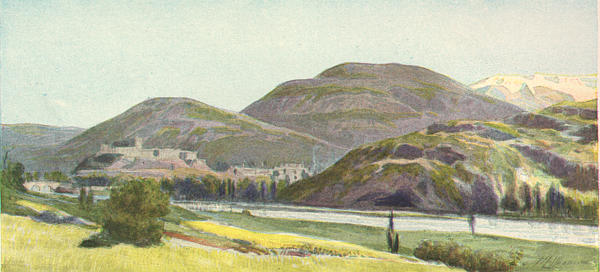
Grotto of the Holy Virgin -- Lourdes. Lourdes is a small village in the south of France, at the common entrance to several deep gorges of the Pyrenees. Near the town is an almost perpendicular cliff known as Massabielle, which means, in the dialect of the country, 'The Old Rocks." In this cliff is a natural grotto about twelve feet high and twelve feet deep, within which is a sort of niche about six feet high, of almost oval shape. It was in this niche that on the 11th of February, 1858, the Virgin Mother of God appeared to the little shepherdess, Bernadette Soubirous, who was gathering sticks along the banks of the neighboring stream. Her form, full of divinest grace, 'was surrounded with an aureole of inconceivable brightness, not like the piercing light of the sun, but rather like a bundle of rays softened by a gentle shade, which irresistibly attracted the gaze, and on which the eyes reposed with ecstatic delight.' She held a chaplet, whose milk-white beads were gliding one by one through her fingers, while she seemed to be listening to the recitation of the rosary throughout the world. Again and again Bernadette went to the spot accompanied at first by a few of her child companions, and afterwards by crowds of people, and each time beheld the same gracious vision, at the sight of which her person was so transfigured that her every movement and gesture had a nobleness and dignity that seemed to onlookers more than human. The glorious apparition sometimes spoke to her, and once, after imparting to her a secret of personal import, regarding which she required secrecy, she commanded her to tell the priests that she wished a chapel built there in her honor. The celestial visitations still continued for a time; a copious spring of water burst forth in the cave at the Virgin's command, though it had always before been perfectly dry, and Bernadette was commanded to drink of the water and to bathe herself with it. At last, on the feast of the Annunciation, in response to a request made by Bernadette on an earlier occasion, that she should reveal in unmistakable terms her identity, the fair Vision raised her arms toward heaven, with the words, 'I am the Immaculate Conception." Thus did the definition of the apostolic doctrine of the perfect and perpetual purity of the Mother of God receive a special confirmation from her own sweet lips, and prepare the way for the rich outpouring of Divine favors which soon followed.
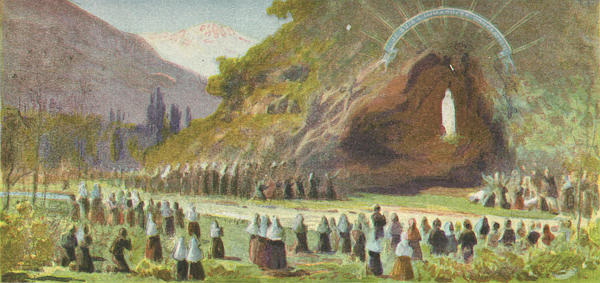
For the fervor with which the villagers received this celestial manifestation soon communicated itself to all parts of the Christian world. A great basilica was built at an enormous cost above the grotto, and other buildings were put up one after another until the whole city has arisen around the sacred spring, whose waters have flowed throughout the world, their channels marked by miracles of bodily and spiritual healing. Shrines in honor of Our Lady of Lourdes have sprung up even in the most distant places, and the wonders worked by Our Lady's intercession under this title have everywhere confuted the enemies of the supernatural.
In the spot where the Blessed Virgin appeared stands a life-size statue conforming to the description given by Bernadette, and at its base still grows the wild rose which the feet of the Holy Virgin touched. The upper church of the basilica is lined with the silken banners of various nations and confraternities and guilds, which have been hung there by visiting pilgrims. . . .
His detailed description of this world-famous church and shrine follows.
Church of the Holy Rosary -- Lourdes 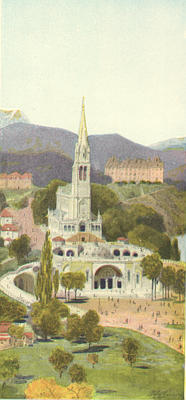
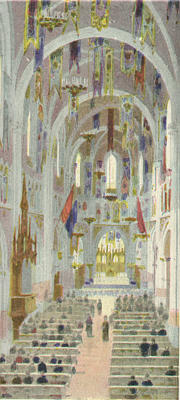
The church of the Holy Rosary at Lourdes consists of an upper and a lower church quite distinct and necessitating distinct descriptions. The lower church, usually called the Church of the Grotto, is built just below the apse of the basilica and was blasted out of the solid rock. Thus it may be said that the Almighty himself not only laid the foundations of the Church of the Grotto but even raised its walls; the work of man has been merely to carry away the debris. It has no windows, light being admitted through a cupola, and not a single pillar supports the roof and arch; it reminds one of the subterranean vaulted chapels so common in old cathedrals.
The glory of the basilica, however, is the interior of the upper Gothic church, where all the great celebrations of feasts are held. Simple in its design it owes all its splendor to the beauty of its decorations. There are magnificent silken banners woven in every country and in every clime testifying to the gratitude of thousands of pilgrims, while ensigns of the great powers droop in a semicircle around the sanctuary, the Stars and Stripes being conspicuous in the foreground. The magnificent blaze of color produces an effect which description can hardly exaggerate. The walls of the church and the long corridors of the crypt are covered with marble tablets commemorating cures and other favors attained through the intercession of Our Lady at her world-famed Grotto.
Among the many lights which are burning before the high altar is one whose flame is never extinguished. It was called the 'lamp of Ireland' because its anonymous donor was a native of the 'ever-faithful isle;' and there it will burn as long as the church stands in that far away valley of the Pyrenees, symbol of a Faith that never dies.
Stranger and more distinctive signs and symbols are those laid down by repentant sinner's at the feet of the Virgin, so that the whole world may see that there have lived strong men who have put away those things hurtful to their spiritual life and growth. There is a battered bronze medal, the Victoria Cross for which thousands of England's sons have died; there a grand cordon of the Legion of Honor; there are swords that are now sheathed and left to rust in this court of peace. There, most magnificent and singular of all, is a strangely shaped miniature in a jeweled case closed forever to the world; the face perhaps of some darling sin or unholy desire.
Surely the human heart is here naked in all its weakness, superb in all its strength!
Although there have been a great many pilgrimages at Lourdes -- notably the Festival of the Banners in 1872, and the English pilgrimages of 1883 -- when all France assembled to implore Mary's intercession for their stricken land, nevertheless there is no special history of the pilgrimages to the Grotto chiefly for the reason that the greatest cures have been wrought in obscurity and quiet and upon those of the humblest origin. God loves to work in silence and in His own good time, acting not when the world is on tiptoe for the event but when the world is asleep or absorbed in trivialities. The population in the mountains and valleys in the neighborhood form the most constant train of visitors, but the pilgrimage is also made by thousands every year from all parts of France, Belgium, Spain and Germany, by many from England, Russia and America, and even by pilgrims from the far east, eager to see the spot touched by the feet of the Virgin and to implore her intercession in their earthly and spiritual needs.
Above the main entrance to the basilica, let into the white stone of the facade, is a large enamel portrait of Pope Pius IX, who proclaimed the dogma of the Immaculate Conception.
It seems fitting that the most ardent champion of Our Lady should have a place of honor in her church, and significant truly that here the peasant girl Bernadette and the pontiff of the universal Church, the genial Pio Nono, are side by side, all earthly distinctions merged and lost in their one title -- children of our Blessed Mother.
__________ 'Rich men and nobles gave their gold and silver, and delicately- nurtured ladies spent night and day in embroidering banners which cities, and towns and rural parishes unanimously agreed to send with their delegates to Lourdes, to be first laid at Mary's feet, and then suspended like so many trophies from the vaulted roof of the church of Massabielle. Men and woman of every rank and station, and from every part of France, assembled with immense enthusiasm and kept up the festival for several successive days. On Sunday morning High Mass was celebrated on a magnificent altar erected in the vast meadows below the grotto, and the bishops of France pronounced their own benediction and that of the sovereign pontiff upon the immense hosts of pilgrims. It was impossible not to feel as if France herself were actually present there, kneeling penitent and forgiven at the feet of her Creator.'
The additional books I'd checked out were all written by authors who did not live in Bernadette's time. They were interesting and informative but most of them were written from researched material. I checked the Notre Dame library database and found the earliest book listed about Bernadette, an English version of a French book, called Our Lady of Lourdes by Henri Lasserre,(188) written during her lifetime. It was the same book mentioned by Father Sorin(189) in reference to the Saint Mary's Grotto. He had informed the Sisters, in 1878, that it was soon to be printed in English.
On January 1, 1870 the Ave Maria also reprinted a review of
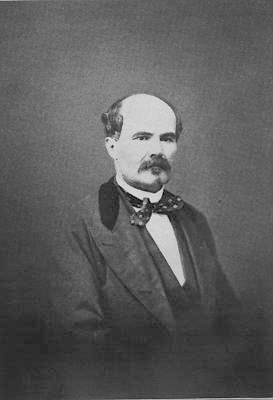 Lasserre's book from the London Lamp:
Lasserre's book from the London Lamp:
Henri Lasserre, Bernadette's historian and author of Our Lady of Lourdes, has taken almost incredible trouble to verify every fact which he relates. He has given the names and addresses of a host of witnesses both to the original facts and to the cures effected in consequence. The most incredulous man amongst us would be compelled, in the face of such evidence, to hesitate before declaring the whole matter to be the offspring of imagination; while the marvelous disinterestedness and simplicity of the peasant girl and her family, to whom these singular revelations were made, go far to set aside the opposite assertion "that the whole thing was an intrigue, and a pretext to get money out of the credulous." Equally remarkable are the extreme reticence and prudence of the clergy, and especially the Bishop, who was one of the very last to give in his adhesion to the popular belief, and for the first few months utterly forbade his clergy to take any part in the proceedings, or even to visit the grotto. The cry of priestcraft, therefore, falls equally to the ground.
On May 28, 1870, another review of Lasserre's, Our Lady of Lourdes was reprinted in the Ave Maria entitled, "Pilgrimages in the Pyrenees and Landes." It was written by the same reviewer, Denys Shyne Lawlor:
It is impossible to read this account of the gifted author's sojournings in the "Land of visions" -- without feeling the heart throb with increased devotion and love for our ever Blessed Mother. . . . We tread with him the winding banks of the Gave . . . or kneel in the Grotto of Lourdes, where, in our own day, wonderful visions have been granted to the simple and pure-hearted little shepherdess, Bernadette. . . .
I do not know in the whole range of modern literature any work that exceeds Notre Dame de Lourdes in eloquence of description, accuracy of detail, accumulation of proof, force of reasoning and earnestness of conviction. No honest-minded person can peruse it carefully and refuse to believe that the Blessed Virgin did personally appear at the grotto of Massabielle to Bernadette Soubirous, and that she confirmed her apparition by numerous miracles.
Both books were just what I'd been looking for, most especially Henri Lasserre's. I found it fascinating to be reading something written when people who witnessed the apparitions were still alive to be interviewed. It was very well done and probably as good a book on the subject available. It starts with a personal prologue, as Werfel did in The Song of Bernadette explaining how the book happened to be written. It follows with a forthright, detailed description of all elements of the apparitions with exception of the personal side of Bernadette's life in the convent which would not have been available to the author at that time as she was still living.
In Lasserre's book, which was published in 1875, the author also tells of his own healing and that of another close friend's son. In his thought-provoking "Dear Reader" letter (quoted in my Author's Personal Epilogue) he speaks of the extraordinary providential circumstances that led to his becoming Bernadette's official historian. His words fueled my search and inspired my own efforts to become a dedicated documentarian.
Henri Lasserre concludes his book with this interesting observation:
She lives in the humility of the Lord and is dead to the vanities of this lower world. This book, which we have written and which speaks so much of Bernadette, will never be read by Sister Marie-Bernard [her religious name].
The later book, written by Franz Werfel, which was made into the 1943 Song of Bernadette film, was based on Lasserre's book. Both books start with unusual personal prologues which explain how and why the books were written.
Werfel describes Bernadette as "a little creature clear as well water and yet inscrutable." Seaton's dialogue in the film portrays her protector, Dean Peyramale, once disbelieving, who then encouraged her:
Lasserre describes Bernadette's last visit to the Grotto:
On the sixteenth of July, the feast of Our Lady of Mount Carmel, Bernadette had heard within her the voice which had for some months been silent, and which now no longer summoned her to the Rocks of Massabielle, then closed and guarded, but to the right of the bank of the Gave into those meadows where the multitude used to assemble to pray, safe from prosecutions and the vexatious proceedings of the Police. It was about eight o'clock in the evening. Scarcely had the child knelt down and commenced the recitation of her chaplet, when the Blessed Mother of Jesus Christ appeared to her. The Gave, which separated her from the Grotto, had almost vanished from her sight as soon as the ecstasy came over her. She saw naught before her but the blessed Rock -- to which she seemed to be as near as on former occasions -- and the Immaculate Virgin, who smiled sweetly upon her as if to confirm all the past and shed light on all the future. Not a word proceeded from her divine lips. At a certain moment She bowed Her head towards the child as if to tell her, "We shall meet again at some very distant period," or to bid her a last farewell. After this She disappeared and re-entered Heaven. This was the eighteenth Apparition and it was the last.
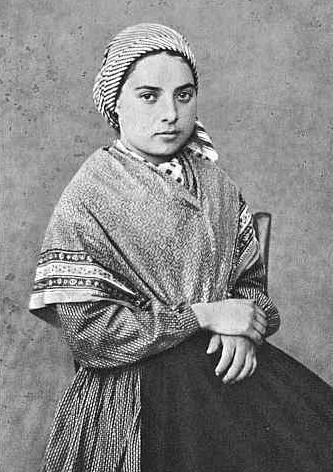
Bernadette's personality is reflected in pictures taken of her as a child during and after the apparitions. She became the first Saint photographed in her lifetime. In Lasserre summation of Bernadette's visions he paints a profound word portrait of the distinctive personal qualities that endeared Bernadette's to all who knew her or were touched by her story:
The testimony of the young girl offers all the guarantees we can possibly desire. There cannot be the slightest doubt as to her sincerity. Who does not, when coming in contact with her, admire her simplicity, modesty and candor? While everybody is discussing the marvels which have been revealed to her, alone, she remains silent. She never speaks unless when questions are put to her; then she enters into details without the slightest affectation, and with the most touching ingenuousness; and her answers to the numerous questions addressed to her are given without hesitation; are clear, precise, very much to the purpose, and bearing the impress of deep conviction.
Subjected to rough trials, she has never been shaken by threats, and she has declined the most generous offers with noble disinterestedness. Always d'accord avec elle-meme, she has in the different interrogatories to which she has been subjected, constantly adhered to her first statement, neither adding to nor taking away from it. Let us add that it has never been contested. Even those who opposed her, have themselves rendered her this homage.
But granting that Bernadette had no wish to deceive others, is it not possible that she was deceived herself? For instance, did she not fancy she saw and heard what she neither saw nor heard? Was she not the victim of a hallucination? How could we believe this for a moment? This wisdom of her replies reveals in the child a soundness of mind, a calmness of imagination, and a fund of good sense beyond her years. In her the religious feeling has never displayed any over-excited character; it has never been proved that she suffered from any intellectual derangement, oddity or disposition, or morbid affection which might have predisposed her to indulge in creations of imagination. She has had this vision, not once only, but as often as eighteen times; she saw it for the first time suddenly, when nothing could have prepared her for what was to be accomplished later on; and during the Quinzaine, when she expected to see the vision every day, she saw nothing for two days, although she was placed in the same way and in identical circumstances. And then what took place during the time the Apparitions were before her? Bernadette was transformed; her countenance assumed a new expression, her eyes kindled, she saw things which she had never before seen, she heard language which she had never before heard, the sense of which she did not always understand, but the remembrance of which she did not fail to retain. These circumstances joined together, preclude the idea of hallucination. The young girl has therefore really seen and heard a being styling herself the Immaculate Conception, and it being impossible to account for the phenomenon naturally, we have just ground for believing that the Apparition was supernatural.
The testimony of Bernadette -- in itself of considerable importance -- acquires altogether new strength -- we might say its complement -- from the marvelous occurrences which have taken place since this event. If a tree should be judged by its fruits, we may affirm that the Apparition, as narrated by the girl, is supernatural and divine, for it has produced supernatural and divine effects. What then happened, dearly beloved Brethren? The Apparition was scarcely heard of, when the news spread with the rapidity of lightning; it was known that Bernadette was to repair to the Grotto for the space of fifteen days, and the whole country was aroused. Crowds of people streamed towards the place of the Apparition; they waited for the solemn hour with religious impatience; and while the girl, beside herself with ravishment, was absorbed by the object of her contemplation, the witnesses of this prodigy, deeply affected and melted to tenderness, were mingled in a common feeling of admiration and prayer.
The Apparitions have ceased; but the concourse of people continues, and pilgrims, arriving from distant countries as well as from the neighboring districts, hasten to the Grotto. They are of all ages, all ranks and all conditions. And by what feeling are these numerous strangers urged to visit the place? Ah! They come to the Grotto in order to pray and to demand favors of one kind or other from the Immaculate Mary. They prove, by their collected behavior, that they are sensible as it were of a divine breath which vivifies this rock, from henceforth forever celebrated. Souls, already Christian, have become strengthened in virtue; men frozen with indifference have been brought back to the practices of religion; obstinate sinners have been reconciled with God, after Our Lady of Lourdes had been invoked in their favor. These marvels of grace, bearing the stamp of universality and duration, can only have God for their author. Consequently, have they not come for the express purpose of confirming the truth of the Apparition?

Near death, Bernadette was asked one more time to describe the Blessed Virgin. She replied, "The lady cannot be drawn or painted or embroidered." In her last moments, Werfel speaks of the nuns at her death having "a sense of being, as it were, midwives of the supernatural birth of a soul into another world."(190) Bernadette died in 1879. She was 35 years old.